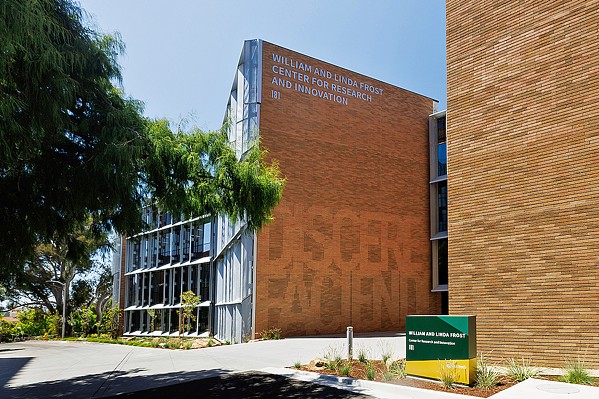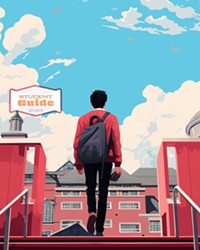Cal Poly's Kennedy Library renovation has been years in the making.
From fixing temperature issues that plague the inside of the building, to structural changes that are needed in any 40-year-old building, to increasing the number of seats available to patrons—the project plans to address it all.
However, with an estimated completion slated for the summer of 2025 and a full shutdown of the building and its facilities, the renovation project presents myriad opportunities and challenges for the campus and its students.

For some like Anthony Palazzo—who serves as executive director of Facilities Planning and Capital Projects for Cal Poly—the renovation project is an opportunity to make a library that's essential to students, more accessible and safer.
Outside of safety and seismic adjustments, some of the new features will include an additional 300 study seats, a new Starbucks cafe on the second floor, all-gender bathrooms, the expansion of the 24-hour section to the second floor, and improved air conditioning—something Palazzo hopes is to the delight of many students.
"The upgrades are touching every floor in some way, especially in terms of air conditioning," he said. "With this new air conditioning, not only are we providing better overall airflow to some of the lesser temperate areas of the library, but we are also reducing our energy usage in the building by around 40 percent."
However, for current students like Wine and Viticulture senior Cooper Durkey, the project has become a symbol of dread and a reminder that he will not have access to a core part of his campus routine.
"It affects a lot of people," Durkey said. "It's where people meet up, it's where we would go in-between classes, it's where I go to do homework—there are just so many day-to-day situations it will impact."
He feels that while the university did inform students like himself, there wasn't much communicated aside from the obvious fact that the library wouldn't be open.
"We have been given pretty little info beyond them sending emails out telling us they planned on closing it," he said. "We have known about it, but that doesn't make it any less inconvenient."
Durkey feels that more than anything, that centralized location often offered students like him a study sanctuary—even with seating available at multiple places across campus.
"If I don't have a place I know I can study away from people that isn't my own house or apartment, that's going to hurt how well I can study," he said. "Having that quiet place to work isn't something some extra seats are going to be able to replace."
Beyond just his personal experience, Durkey noted that by spreading out the resources offered traditionally under one roof, students may find themselves struggling to handle the workload of classes.
"I think this will affect some of the academic stuff most students deal with," he said. "I do think it's unfair because we are losing a centralized location where a lot of things like Scantrons, printers, and computers were located."

- Photo Courtesy Of Cal Poly
- FAR INTO THE FUTURE As construction begins at Cal Poly's Kennedy Library, the recently opened William and Linda Frost Center will serve as one of the temporary hosts, offering seating for students to study.
Many students have also questioned the timing of the construction, wondering why the university picked the foot-traffic-heavy start of the school year to begin construction.
"That sidewalk in front of the library is something that almost everyone I know walks through at some point in the day to get to their classes or cars," Durkey said. "It's going to cause a lot of foot traffic and create a ton of noise and dust."
Palazzo told New Times that students can expect those demolition efforts and construction to continue into the fall and winter quarters.
"Right now we have just started the process of soft demolition, which includes light future teardown on the inside and moving all of the books and resources out," he said in early September. "By the time school starts we will be undergoing a full demolition and the middle of the fall quarter, that's when the big work starts to happen."
Palazzo and Cal Poly say that books, computers, study space, and other resources will be available throughout the entire renovation process.
"The library is not closing, it's just the building itself that won't be accessible," he said. "Instead its resources have just been spread throughout campus, and the only thing changing as far as what is available to students is that physical building."
Students will continue to be able to access highly requested books via an online portal, with physical copies available at different locations on campus. They will also have access to temporary study sections in parking lots beneath big white tents with seating and other amenities.
"We want to give students as many study spaces as we can while renovation is happening," Palazzo said. "While we are not going to have the exact number of seats, we are adding seating to wherever we can."
He added that his team was teaming up with Cal Poly's Associated Students Inc. to help provide even more seating for students in gathering places at the campus's core.
One of those temporary seating solutions is the Frost Center—a new building at the center of campus that will provide some of the much-needed seating both during and after the library renovation.
While he acknowledged the undeniable impact the closure will have on current students, Palazzo said that in the long run, these renovations will vastly improve the overall accessibility of campus resources.
"We would never have the ability to do a full-scale one-to-one replication of what existed at the library before its closure," he said. "It would have been cost-prohibitive to pursue anything like that, so we did what we could."
Palazzo is hopeful that—as they march toward the 2025 completion date—the new resources will represent a brighter future for incoming students and highlight just how many resources the campus has outside of the library.
"Our goal [in this renovation effort] is to make campus resources more accessible for those who use them," he said. "We want to counter the idea of, 'Oh well I am not going to use [the library or this space] because x, y, and z isn't there."
But as students like Durkey begin their fall classes, they grapple with university-offered solutions that don't make them feel like a priority.
"It feels like all of these things they put together to accommodate for this renovation project were afterthoughts," he said. "I don't feel like these temporary solutions are going to offer the help that students need to succeed, and in the end isn't that what is important?" Δ
Reach Staff Writer Adrian Vincent Rosas at [email protected]



Comments
Showing 1-1 of 1